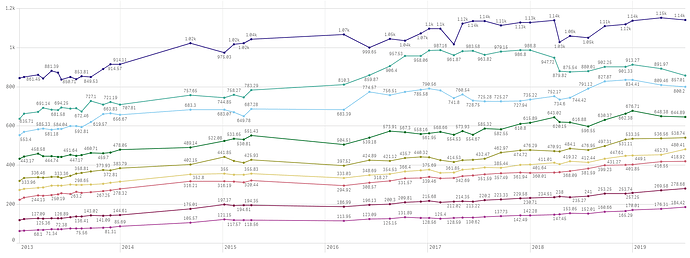So I have my own philosophy on the concept - and the way that I gauge overall point inflation/disparity is by considering the following:
There are 3 types of tournament pinball players, those being local only, regional, and traveling.
Local only are a majority of players and start within a city/ county, etc. The only time they participate in a circuit tournament is if it is within driving distance and convenient.
Regional are players who are willing to travel marginal distances and occasional play in multi day tournaments. They may drive 4+ hours or get on a short flight. They also play locally.
Travelers have access to enough resources it enough commitment to venture to circuit events on a rather consistent basis. They play in everything within driving distance and also participate locally when desired.
Each one of these players has access to a certain number of tournaments, and in turn a certain amount of WPPR points - this point value is what I call the Maximum Point Value (MPV) - and this caps out differently based on A) the type of player you are and B) Where you live.
To calculate MPV is rather simple, figure out the highest tournament value that you can obtain regularly and multipliers that by how many tournaments count towards your IFPA Ranking. Then look up that point value on the current standings (or on a resource like @BMU above) to see your Maximum Achievable Rank (MAR).
This is easiest to calculate for local players, as other players would need to estimate what they can regularly obtain based on the tournament they choose to participate it.
For example - Person A lives in San Diego, CA, the average tournament in that area is 10 wppr’s. Person A’ MPV is 10 * 20 = 200. Looking at the current world standings 200 points would put you in 442nd place - therefore person A’s MAR is 442.
Let’s say Person B lives in Myrtle Beach, SC - there the average tournament has fewer people and average 4 WWPR points per tournament. MPV is 4 * 20 = 80 and MAR = 1,383. (1,383rd rank).
For regional and traveling players you would access your ability and guess where you would place in a ‘larger’ tournament - add that value minus your local average - and check the rank.
For example, going back to Person A, I am going to INDISC and I estimate that I can place around 24th in that tournament - this would get me 12 points, which would replace one of my estimated 10s. I would then gain 2 points (12-10) on my overall MPV = (10 * 20) + 2 = 202 - and my MAR becomes 432, which is 10 positions better than being local only.
Hope this all makes sense, you could easily graph out an estimate of local average tournament points and see how it impacts over all rank. Ultimately quantity of tornados helps to an extent, and mostly for local only players, after that it becomes a combination of how large the regional tournaments are around you and how willing you are too travel to find bigger tournaments.
This is how I view WPPRs.


 I get questions all the time about ranks/points/etc. And I hear a lot of people complain that they can’t obtain a good rank without tons of travel - or that you can buy your way into the top 250 - I simply counter saying you could get as high as 400th if you won 20 events, so the real prohibitor is not really travel/money.
I get questions all the time about ranks/points/etc. And I hear a lot of people complain that they can’t obtain a good rank without tons of travel - or that you can buy your way into the top 250 - I simply counter saying you could get as high as 400th if you won 20 events, so the real prohibitor is not really travel/money.